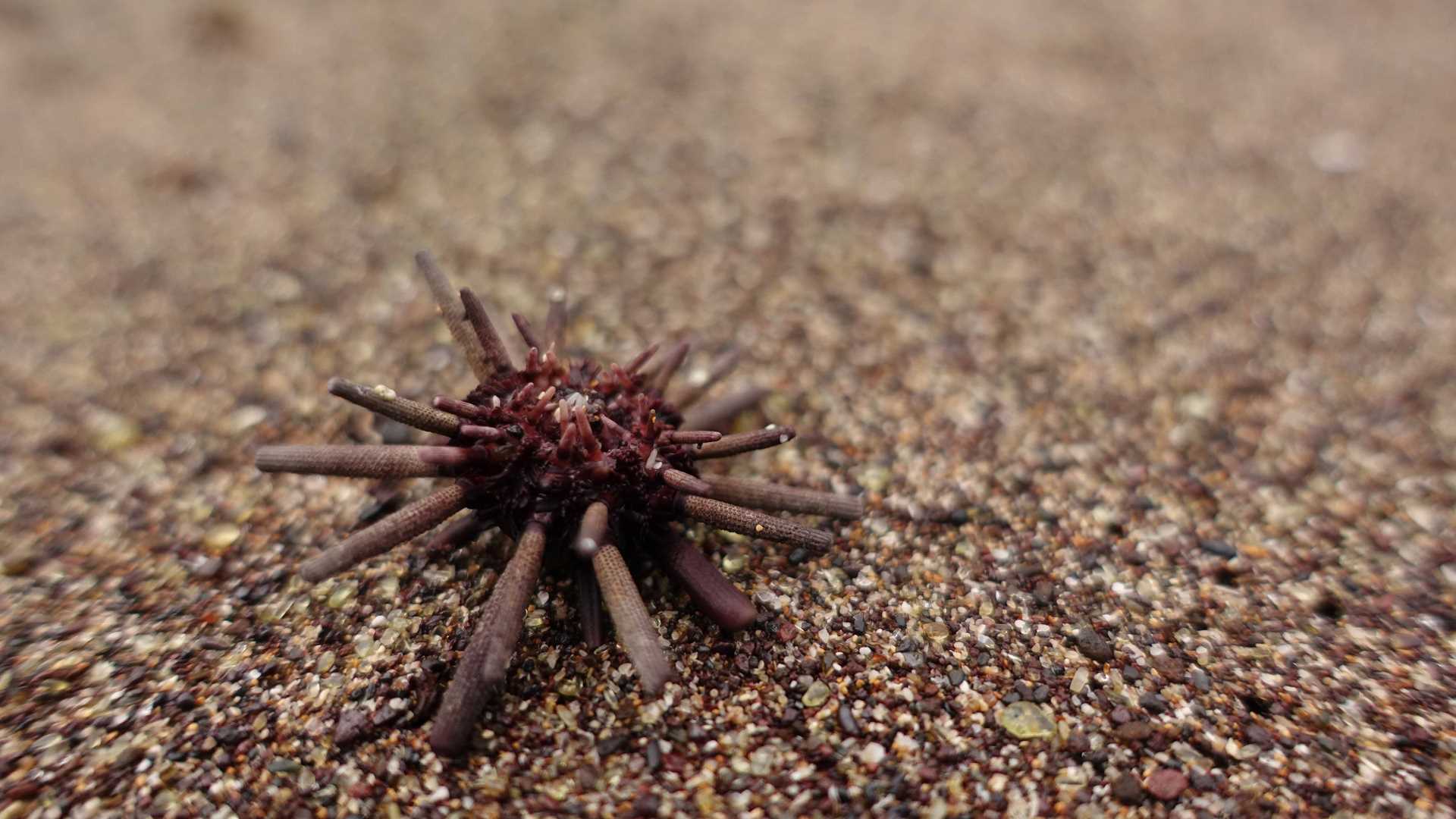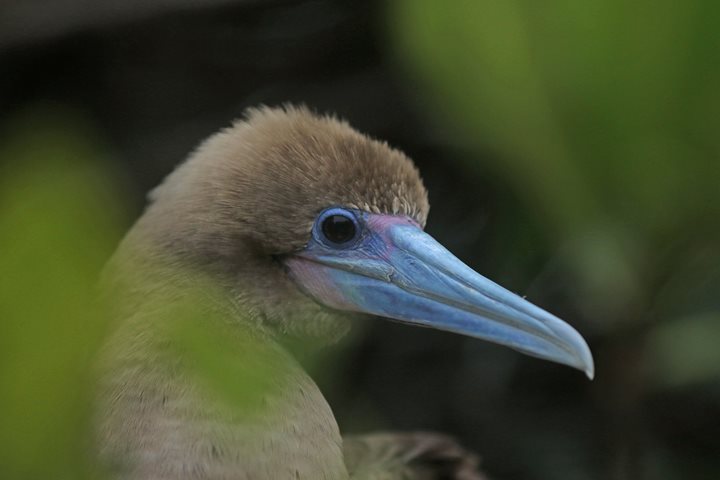Today’s expedition took place on Floreana Island. In the morning we visited Cormorant Point where there is a brackish water lagoon sometimes visited by flamingoes. This time we were very fortunate to spot five adults and two babies feeding on the lagoon, just a few meters away from us. Wildlife was up early at Cormorant Point, as we also spotted diamond rays coming to shore to warm up and flying fish being chased by Galapagos sea lions and frigate birds. We continued the expedition in the water, snorkeling around Champion Islet where we spotted, octopus, eagle rays and many fish such as parrot fish, razor surgeon fish, and giant damsel fish. Besides being rich in wildlife, Floreana is also rich in human history. This island was visited by pirates and buccaneers in the 1500s and 1700s. In the late 1700s a mail barrel was installed to allow sailors to send mail home delivered by future visiting sailors. Our guests had the opportunity to go back in time and be part of this tradition and send and collect mail from Post Office Bay to hand deliver in their hometowns. A penguin bid us farewell and a beautiful sunset accompanied us back to the National Geographic Islander. It was another amazing day in paradise!
- Daily Expedition Reports
- 02 Jan 2018
Floreana Island, 1/2/2018, National Geographic Islander
- Aboard the National Geographic Islander
- Galápagos
Gianna Haro, Naturalist
Most of Gianna´s memories seem to be dreams, made on flawless white sandy beaches with black lava rock contours and gorgeous turquoise ocean waters. Most of it happened while barefoot, in an enchanting place that some people regard as an ideal natura...
Read MoreJason Heilmann, Expedition Leader
Growing up in northern California, Jason was surrounded by the incomparable nature of the Pacific Northwest. While attending university there, Jason met and eventually married an Ecuadorian woman who happened to be from a small group of islands off t...
Read MoreShare Report
Related Reports
7/2/2022
Read
National Geographic Islander
Genovesa Island
Today we spent the last day of our expedition at the island of Genovesa. It took us several hours of navigation to reach the island, which is located in the northern hemisphere and is home for more than a million birds! In the morning, we went out to explore Darwin Bay. We had an easy landing on a white sand beach covered by pieces of white coral. No matter where we looked, we spotted birds everywhere. Indeed, Genovesa Island holds the largest colony of red-footed boobies on Earth. More than 200,000 red-footed boobies are found here. These birds are so beautiful. They have a gorgeous blue beak with a pink mask and a black outline beneath their beaks. Red-footed boobies nest on bushes and trees. Their call is very distinctive and loud, and males and females are alike. During our easy stroll at Darwin’s Bay, our guests were lucky as they witnessed a swallow-tailed gull emerge from its shell. It was a miracle and a wonder of nature. I was fortunate to go kayaking with our guests inside of the protected caldera of Genovesa Island, and we enjoyed our last opportunity for deep water snorkeling. The waters are warmer here, and there are many colorful fish to observe. In the afternoon, we went to Prince Phillip’s Steps. After climbing the uneven steps, we reached the plateau and went to look for the elusive short-eared owl. We were very lucky, as we spotted two owls right by the trail. This is the best time of year for the owls. The storm petrels are nesting, and there is plenty of food for the owls. We went back onboard with feelings of amazement and gratitude. Galapagos is like the Garden of Eden. Humans encounter nature, and animals are not afraid of us. Those are the gifts that we keep for the rest of our lives!
2/1/2022
Read
National Geographic Islander
Isabela and Fernandina Islands
We woke up early in the morning as National Geographic Islander navigated along the northern part of Isabela Island. Slowly the sun appeared above the clouds surrounding Volcano Wolf. We spotted our first birds as Galapagos fur seals returned to shore from their night hunt. We enjoyed a great breakfast. Afterward, expedition leader Vanessa called everyone to the bow to celebrate as we crossed the equator. Our guests happily crossed the line. Approaching Punta Vicente Roca, the visitor site, we spotted Galapagos sea lions and a good number of ocean sunfish. The first activity of the day took place as we dropped anchor at Punta Vicente Roca. This is a spectacular geological site. The combination of the former volcano’s tall cliffs and the tuff cones formed later adds an amazing contrast to this unique visitor site. Our best tools for exploration, our Zodiacs, were lowered down, and off we went to explore the coast. We observed Nazca boobies and blue-footed boobies resting on the small ledges of the tuff cones. Galapagos sea lions swam close to our Zodiac, and Galapagos penguins rested on a broken piece of the tuff cone after feeding. What a wonderful sight! In a calm area, we found a good number of Pacific green sea turtles. The morning’s activities ended with snorkeling. Pacific green sea turtles, plenty of colorful fish, Galapagos marine iguanas and flightless cormorants surrounded us. It was a phenomenal experience! The ship was repositioned toward Fernandina Island. The youngest island of the archipelago, Fernandina is a highlight of our expedition. This island shows our guests the beginning of life. We observed animals thriving in the hostile environment. Pioneer plants like lava cacti grow on the lava fields, breaking down rocks little by little to create soil for the next generation of plants. Punta Espinoza is known for its huge colony of Galapagos marine iguanas. It is hard to distinguish the iguanas from rocks since they are so dark in color. On the other hand, colorful Sally Lightfoot crabs added contrast to the young, dark lava fields. We ended our walk as the sun was setting, returning to the ship with great memories. It was a fantastic day in the western part of the archipelago.









